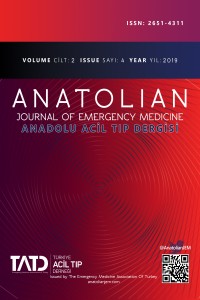Abstract
Aim
The aim is to identify the temperament and charactertraits’ scores of Emergency Medicine Physicians (EMPs) andthe differences within their demographic variable factors.
Material and Methods
The volunteers were assessed from December 2016 to April2017. The study protocol was approved by the UniversityInstitutional Review Board (no. KA16/352). The study group was patterned on EMPs, completed an Emergency Medicineresidency programme and working in an Emergency Department (ED). Novelty seeking (NS), harm avoidance
(HA), reward dependence (RD), persistence (P), selfdirectedness (SD), cooperativeness (C), and selftranscendence (ST) measures and sub-measures were evaluated.
Results
There was total number of 40 EMPs that voluntarily participated the study and completed Temperament and Character Inventory (TCI) which includes 240 questions. Position was a significant factor in extravagance (p=0.040), fatigability (p=0.021), harm avoidance (p=0.037), and purposeful (p=0.015). The other significant variable factors were: Age in exploratory excitability (p=0.010), fatigability (p=0.012), and pure-hearted conscience (p=0.041); Sex in shyness (p=0.004), harm avoidance (p=0.048), resourcefulness (p=0.009), self-acceptance (p=0.024), enlightened second nature (p=0.001), self directedness (p=0.001), social acceptance (p=0.027), compassion (p=0.006), and cooperativeness (p=0.013).
Conclusion
Position degree, age and sex are the main effective determinants of temperament and character traits of EMPs. Supportive plans can be made based on these differences.
Supporting Institution
BASKENT UNIVERSITY SCHOOL OF MEDICINE
Project Number
KA16/352
References
- 1. Cloninger CR, Svrakic DM, Przybeck TR. A psychobiological model of temperament and character. Arch Gen Psychiatry 1993; 50: 975-989.
- 2. Laricchiuta D, Petrosini L, Piras F, Macci E, Cutuli D, Chiapponi C, et al. Linking novelty seeking and harm avoidance personality traits to cerebellar volumes. Hum Brain Mapp. 2014; 35: 285-96.
- 3. Kluger MT, Laidlaw TM, Kruger N, Harrison MJ. Personality traits of anaesthetists and physicians: an evaluation using the Cloninger Temperament and Character Inventory (TCI-125). Anaesthesia. 1999; 54: 926-35.
- 4. Kose S, Sayar K, Ak I, Aydin N, Kalelioglu U, Kirpinar I , et al. Turkish version of the TCI: Reliability, validity, and factorialstructure. Bulletin of Clinical Psychopharmacology 2004;14: 107- 131.
- 5. Eley DS, Eley RM. Personality traits of Australian nurses and doctors: challenging stereotypes? Int J Nurs Pract. 2011; 17:380- 7.
- 6. Richter J, Aström S, Isaksson U. Personality characteristics of staff in elderly care-a cross-cultural comparison. Issues Ment Health Nurs. 2012 ; 33: 96-100.
- 7. Sievert M, Zwir I, Cloninger KM, Lester N, Rozsa S, Cloninger CR. The influence of temperament and character profiles on specialty choice and well-being in medical residents. PeerJ. 2016;4:e2319.
- 8. Vaidya NA, Sierles FS, Raida MD, Fakhoury FJ, Przybeck TR, Cloninger CR. Relationship between specialty choice and medical student temperament and character assessed with Cloninger Inventory. Teach Learn Med. 2004;16:150-6.
Abstract
Amaç
Amaç, Acil Hekimlerinin (AH) mizaç ve karakter özelliklerinin puanlarını ve demografik değişken faktörlerindeki farklılıkları tespit etmektir.
Gereç ve Yöntemler
Gönüllüler Aralık 2016-Nisan 2017 tarihleri arasında değerlendirildi. Çalışma protokolü Üniversite Araştırma Kurulu (KA16 / 352) tarafından onaylanmıştır. Çalışma grubu Acil Tıp uzmanlık eğitimi olan ve aktif hekimlerden oluşmuştur. Yenilik arayışı, zarardan kaçınma, ödül bağımlılığı, sebat, kendini yönetme, işbirliği ve kendini aşma ölçütleri ile alt ölçütleri değerlendirildi.
Bulgular
240 soru içeren Mizaç ve Karakter Envanteri çalışmasına toplam 40 AH katıldı. Pozisyon, savurganlık (p = 0.040), çabuk yorulma ve dermansızlık (p = 0.021), zarardan kaçınma (p = 0.037) ve amaçlılık (p = 0.015) için anlamlı bir faktördü. Diğer anlamlı değişkenler şunlardı: Yaş ile keşfetmekten heyecan duyma (p = 0.010), çabuk yorulma ve dermansızlık (p = 0.012), erdemlilik-vicdanlılık (p = 0.041); cinsiyet ile yabancılardan çekinme (p = 0.004), zarardan kaçınma (p = 0.048), beceriklilik (p = 0.009), kendini kabullenme (p = 0.024), uyumlu ikinci huylar (p = 0.001), kendini yönetme (p = 0.001), sosyal onaylama (p = 0.027), acıma (p = 0.006), işbirliği yapma (p = 0.013).
Sonuç
Pozisyon derecesi, yaş ve cinsiyet, AH'lerde mizacın ve karakter özelliklerinin en etkili belirleyicileridir. Bu farklılıklara dayanarak destekleyici planlar yapılabilir.
Project Number
KA16/352
References
- 1. Cloninger CR, Svrakic DM, Przybeck TR. A psychobiological model of temperament and character. Arch Gen Psychiatry 1993; 50: 975-989.
- 2. Laricchiuta D, Petrosini L, Piras F, Macci E, Cutuli D, Chiapponi C, et al. Linking novelty seeking and harm avoidance personality traits to cerebellar volumes. Hum Brain Mapp. 2014; 35: 285-96.
- 3. Kluger MT, Laidlaw TM, Kruger N, Harrison MJ. Personality traits of anaesthetists and physicians: an evaluation using the Cloninger Temperament and Character Inventory (TCI-125). Anaesthesia. 1999; 54: 926-35.
- 4. Kose S, Sayar K, Ak I, Aydin N, Kalelioglu U, Kirpinar I , et al. Turkish version of the TCI: Reliability, validity, and factorialstructure. Bulletin of Clinical Psychopharmacology 2004;14: 107- 131.
- 5. Eley DS, Eley RM. Personality traits of Australian nurses and doctors: challenging stereotypes? Int J Nurs Pract. 2011; 17:380- 7.
- 6. Richter J, Aström S, Isaksson U. Personality characteristics of staff in elderly care-a cross-cultural comparison. Issues Ment Health Nurs. 2012 ; 33: 96-100.
- 7. Sievert M, Zwir I, Cloninger KM, Lester N, Rozsa S, Cloninger CR. The influence of temperament and character profiles on specialty choice and well-being in medical residents. PeerJ. 2016;4:e2319.
- 8. Vaidya NA, Sierles FS, Raida MD, Fakhoury FJ, Przybeck TR, Cloninger CR. Relationship between specialty choice and medical student temperament and character assessed with Cloninger Inventory. Teach Learn Med. 2004;16:150-6.
Details
| Primary Language | English |
|---|---|
| Subjects | Clinical Sciences |
| Journal Section | Original Articles |
| Authors | |
| Project Number | KA16/352 |
| Publication Date | December 31, 2019 |
| Published in Issue | Year 2019 Volume: 2 Issue: 4 |


